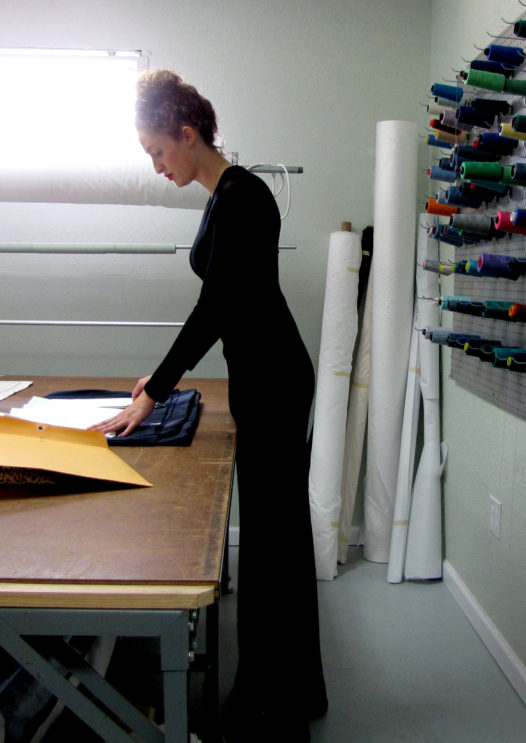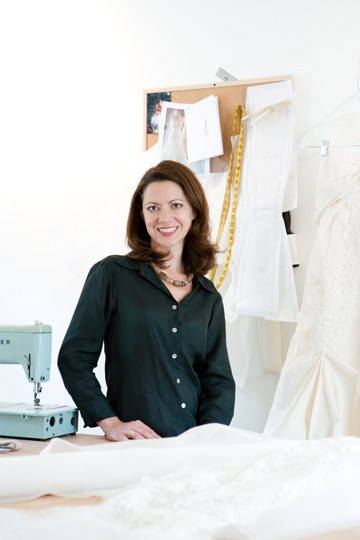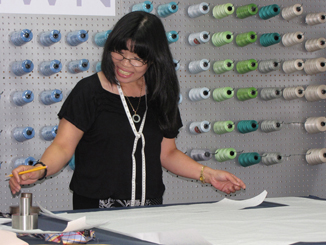
Lisa Iocono
“If people get off on fashion as much as they do food and music and art, which goes without saying they will, then there’s a chance for at least a small sustained garment industry here…and it’s not gonna look like anywhere else.”
Lisa Iacono, a member of the current tribe of young transplants to NOLA, had a sweet job at American Eagle in NYC, designing, traveling … and in the evenings drowning out her workdays at bars with her equally stressed friends. She’s only 27, but has the quiet assurance of someone much older. Maybe it’s the confidence that comes from moving up the ladder in tryouts for Project Runway (more about that later), or doing an internship with Proenza Schouler, where she got great advice from an assistant designer: “Before you leave any internship, ask for a meeting with the president of the company.”
When she did just that at Anthropologie, her cohorts thought she was insane, but she got that meeting, showed him her portfolio, asked how to improve it, and what she could expect in the fashion industry.
“Every single person I spoke to said the same thing; you can’t start your own line, you can’t start your own business, you have to raise millions of dollars, it’s too hard. Well, that made me wonder, ‘How come YOU’RE sitting here?’ “
One of Lisa’s internships from University of Cincinnati was with Suzanne Perron in New Orleans, who had graduated from LSU, then gone on to work with Carolina Herrera and Vera Wang. Perron, who can take a year to make a single gown, is in all the world a rare bird, a true couturier.
As Lisa says, “Couture is in Paris, maybe Italy, there are not 50 people in the world who do it. Her techniques are completely off the radar. The inside of the gown probably takes the most time to make; there are steps in making the foundation that disappear as the process goes on, things you do just to increase the stability and then take out.”
In those three months working with Suzanne, old story — New Orleans got under Lisa’s skin.

Suzanne Perron
Back in New York City on her daily jog through the park, Lisa made eye contact with a daredevil skateboarding musician from Brooklyn. Yeah. Completely out of character for the elegant and shy ex-soccer player, she waved at him.
And so it began. He chided her for working at a job she wasn’t passionate about and said, “Come home after work and make art.”
“So he turned my apartment into a studio,” Lisa says. “I stopped going out for one month, that was January, and by February I was back down here pursuing work for Suzanne again.” Who pushed her and gave her the confidence to launch her own line.
“One day I googled garment manufacturing plus New Orleans and Kenneth Gordon’s name came up. I called him and he talked to me for an hour. At the end he said, ‘I think I know who can help you.’ “
Back in 1975, Tam Huynh was living in the peaceful town of Vung Tau in Southern Vietnam when Saigon fell, and overnight it became a place where neighbor was afraid of neighbor, where a family member could be “disappeared” during the night.
One day her sister quietly told Tam to take the kids, go to this address, and if anyone stops you say you’re going to visit uncle. So at 16, Tam held the hands of her niece and nephew and joined a small group in a darkened house next to the pier. In the middle of the night, they were loaded into the hold of a boat. It took a day to clear Vietnamese waters and a wholly seasick week for Tam to reach Thailand.

Tam Huynh
Tam is a natural leader. She made it to New Orleans and got a job at fine shirtmaker Kenneth Gordon, where she was quickly promoted to director of manufacturing and where she stayed for 22 years, until Hurricane Katrina forced his business out of New Orleans.
Tam adapted, making the move to munitions manufacture (!) and, not surprisingly, again became director of manufacturing. She’s organized, proficient, and knows how to control the flow of materials to finished product, whether it’s a fine shirt or a military tank.
On Kenneth’s recommendation, Lisa and Tam met at her brother’s business, H&S Mechanics Shop, across the river in Harvey, where they discussed the single garment Lisa wanted to produce. She had to be able to deliver factory grade garments if she sold to any stores. It was a case of quality sewing meets great design; Lisa sold to every store she walked into.
Other young designers in town noticed and started asking where she was getting her garments made. Lisa took them to Tam, more and more of them, until finally Tam asked, “Do you want to contract for me?”
And so NolaSewn was born.
“It wasn’t like we sat down and said let’s start a business and get a loan. We already had clients,” Lisa says. The business continues to grow. “I handle the clients; Tam handles the sewers. Without each other it would be too much.”
But NolaSewn is so much more than a business to Tam and Lisa. It’s a business with huge heart that reflects two talented, gentle women, as far away from the madness of New York’s Garment District in spirit as in geography (although New York has noticed: Women’s Wear Daily wrote about NolaSewn in its July 31 edition).
Tam and Lisa value their sewers and the fine handwork they produce. In their hands, “It becomes human, organic. The relationship between the designer and the factory is as crucial as the relationship between the designer and their buyers.”
When Lisa applied for “Project Runway,” and was rising in the ranks of potential contestants, she was asked what she would do if judge Nina Garcia said she hated a garment. Lisa started having misgivings that the TV show wasn’t really so much about fashion design as it was about drama. Her mother called about the same time to express similar doubts. That settled it; she pulled out.
And Tam is an equally tender soul, assisting fellow Vietnamese by translating for them and, when she began Nola Sewn, hiring them in her factory. As she explained in an interview with Missy Wilkenson of Gambit in February 2012: “The opportunity to give back to the community and to employ many first-generation Vietnamese seamstresses is a blessing. … I spent a lot of time finding jobs for people (after Kenneth Gordon closed). I feel like I owe them a lot.”
Being the magnet for creatives that New Orleans is and being the fertile ground for unorthodoxy that it is, it’s no wonder fashion looks different here. As Lisa puts it, “People come to us fresh, unvetted by New York. When you’re designing for one specific customer over and over again, you get washed out; you start to limit yourself because of the costs and hearing ‘NO’ from the buyers so many times. New Orleans is so pure; designers aren’t scared of their own ideas.”
Lisa senses that big things are beginning to happen in the local fashion industry.
“Is it just me, or is something really brewing here”? she recently asked Camilla Franklin, whose textile lineage began on the River Tweed in Scotland at the 200-year-old School for Textile Arts.
“Definitely,” Camilla agreed.
More about the amazing Camilla in the next episode. Meanwhile, I’d agree: There’s a lot more brewing in the New Orleans than coffee and chicory — by a long shot.
The NolaSewn photo gallery below is by Carol Pulitzer:
Artist and writer Carol Pulitzer writes about New Orleans people and places for NolaVie. Read her blog at littletheatre1.com.
 NOLAbeings Multimedia artist Claire Bangser created NOLAbeings as a portrait-based story project that marries...
NOLAbeings Multimedia artist Claire Bangser created NOLAbeings as a portrait-based story project that marries...  Voodoo in New Orleans: Reviving history: New Orleans fortune telling This article takes a deep dive into the history of Voodoo in New Orleans, its hybridization with Catholicism, and its present-day place in the city's culture. The author visits fortune-tellers in the French Quarter, using their guidance as a tool for introspection rather than a deterministic predictor of the future. Through her experiences in New Orleans, the author feels a mystical connection to both the past and the future.
Voodoo in New Orleans: Reviving history: New Orleans fortune telling This article takes a deep dive into the history of Voodoo in New Orleans, its hybridization with Catholicism, and its present-day place in the city's culture. The author visits fortune-tellers in the French Quarter, using their guidance as a tool for introspection rather than a deterministic predictor of the future. Through her experiences in New Orleans, the author feels a mystical connection to both the past and the future. 